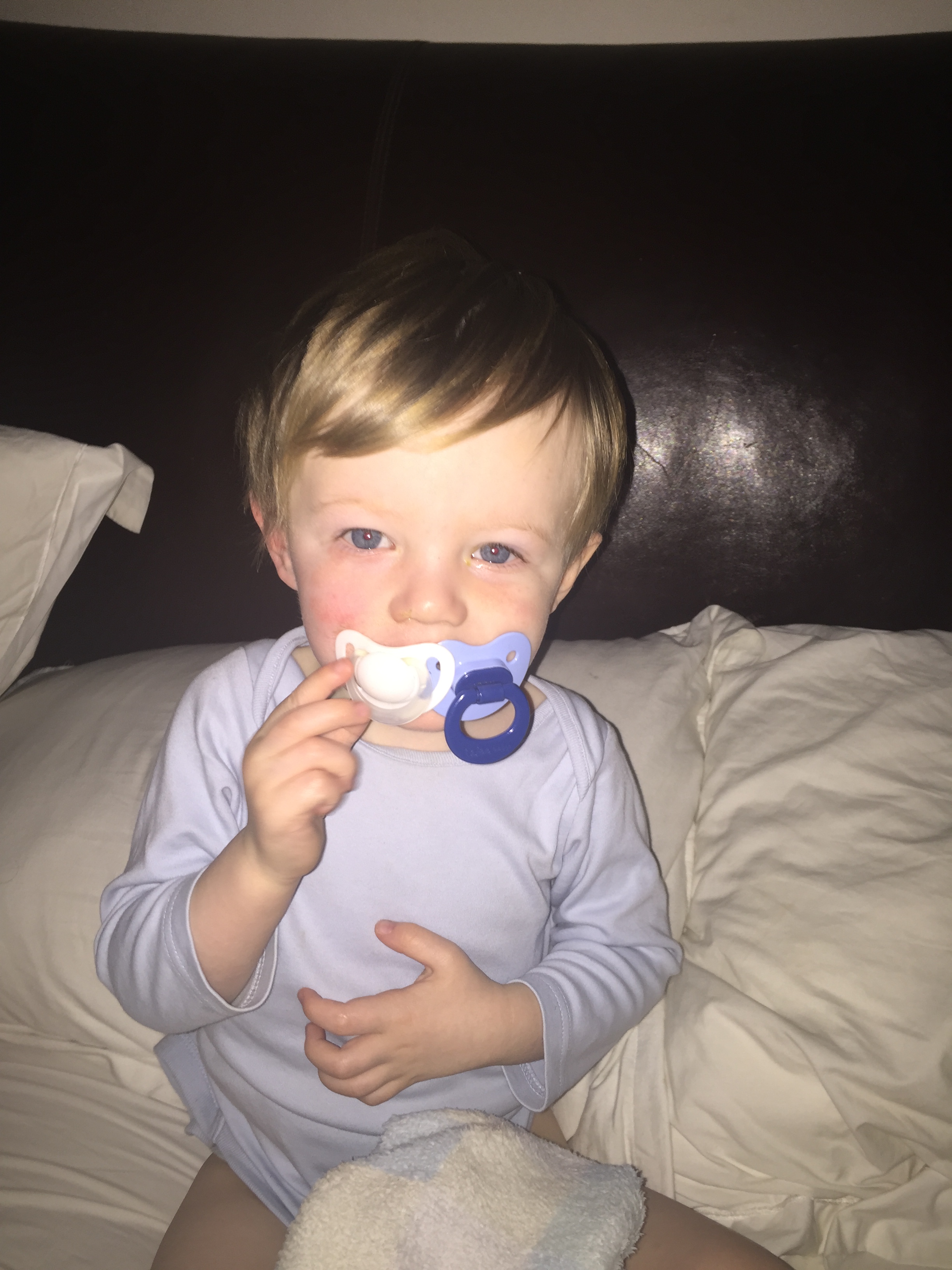So you’ve arrived home with your new gorgeous bundle of joy. You’ve read all the parenting books out there and are doing great caring for your little one. One of the things not on your list is baby’s oral heath-she has no teeth yet, right?
Wrong!
While most babies don’t start getting teeth until they are 6 months old, infant dental care is important from the very beginning. Many dentists recommend an initial visit before the child’s first birthday to make sure teeth and gums are cared for and cleaned properly
Start cleaning your child’s mouth even before her teeth come in.
Wipe the gums off after each feeding with a warm, wet washcloth or a dampened piece of gauze wrapped around your finger. You can also buy thimble-like, soft rubbery devices (they fit over your index finger) to use for rubbing off excess food. This, like when teeth do arrive is to remove bacteria in the mouth and get the infant accustomed with teeth cleaning, putting her in good stead for when her teeth do arrive.
As your child’s teeth start to appear (generally around 6 months), you’ll need to start brushing them. (If your child is healthy and still hasn’t gotten her first tooth by the end of her first year, don’t worry – some children don’t start getting teeth until 15 to 18 months.)
- Brush twice a day. Brush in the morning and right before bedtime. Use a baby toothbrush with a small head and grip suitable for your hand.
- Use a tiny amount of fluoride toothpaste.To avoid giving your child too much fluoride, use a thin smear of toothpaste or a dot the size of a grain of rice. (It’s fine to use any fluoridated toothpaste. Note that many toothpastes marketed for babies don’t contain fluoride.)
- Brush gently on the inside and outside of each of your baby’s teeth, as well as her tongue (if she’ll let you), to dislodge bacteria that can cause bad breath. Remember, there’s no need to rinse.
- Replace the toothbrush as soon as the bristles start to look worn or splayed.
For now, your baby’s teeth are probably far enough apart that you don’t have to worry about flossing. In fact, there’s no evidence that flossing baby teeth makes a difference.
Fluoride
Your baby’s developing teeth can benefit from a little fluoride. (The amount recommended for children under 3 is .25 milligrams per day.) This mineral helps prevent tooth decay by strengthening tooth enamel and making it more resistant to acids and harmful bacteria.
Your baby can get fluoride from toothpaste, water, supplements (if necessary), and a fluoride varnish that his primary healthcare provider or dentist can apply to his teeth.
If the water you use to make your baby’s formula contains fluoride, he’ll get fluoride from his bottle feedings. Some water supplies are fortified with adequate fluoride. (Call your local water authority to find out about yours).
If your water supply isn’t fluoridated or you get your water from a well, you might consider buying a test kit from your local health department, a hardware store, or a pharmacy.
If the fluoride content is less than .3 parts per million, ask your child’s doctor or dentist whether you should give your child a fluoride supplement. The doctor can prescribe fluoride in the form of drops that you can add to your baby’s bottle or cereal once a day. Experts don’t recommend fluoride supplements for babies under 6 months old.
Keep in mind that while a little fluoride is a good thing for your baby’s teeth, too much of it can lead to a condition called fluorosis, which causes white spots to show up on your child’s adult teeth. This is why it’s important to use only the tiniest amount of toothpaste until your child is old enough to rinse and spit it out.
.
What to Expect During Infancy

- Teething– between 3 and 9 months, your infant’s baby teeth will begin to erupt. Teething may make your child irritable or fussy and may cause restlessness, slobbering or loss of appetite, not to mention an off tummy!
- Soothers, pacifiers, dummies, doodeys, do do’s– Boy do they love their dummies!! Sucking is a normal part of development that is comforting to children well into their first years of life. In fact, research shows that sucking a dummy helps to regulate breathing in infants and helps to prevent SIDS. Sucking often brings comfort even after a child no longer needs to get nourishment from a breast or bottle. However, dummies should be taken away from toddlers before their 2nd birthday to prevent orthodontic problems.
- Baby bottle tooth decay– this occurs when acid formed by bacteria on the teeth, from sugars in foods and beverages, damages the tooth enamel. This causes demineralization, and eventually can lead to a cavity.
As your little bundle moves in to solid foods, make sure you’re making the best choices of snacks.
Foods That Help Oral Health

Oranges, kiwis, strawberries, limes, and peppers
There are several different types of bacteria in your child’s mouth, and some of them can cause gingivitis, which is the first stage of gum disease. Vitamin C in fruits such as oranges, limes, kiwis, cantaloupe, papaya, and strawberries helps kill these bacteria, and it also promotes a healthy supply of collagen in the gums. Other good vegetable sources: red, yellow, and orange peppers; tomatoes; and sweet potatoes. However, kids should wait at least 30 minutes before brushing their teeth after having citrus foods or drinks. That’s because citric acid in the fruit can temporarily weaken tooth enamel and leave teeth vulnerable to erosion caused by brushing.
Milk, yogurt, and cheese
Starchy carbohydrates like bread, white potatoes, and pasta break down into sugar. This sugar feeds other types of bacteria in your child’s mouth that produce cavity-causing acid. When your child drinks milk or eats yogurt or cheese — which are rich in calcium, vitamin D, and phosphate — it raises the pH level in his mouth, lowers acid levels, and reduces the risk of tooth decay. Calcium is also beneficial in several other ways: It mixes with plaque and sticks to teeth, further protecting them from lingering acid; it repairs damaged enamel; and it strengthens the bones around your child’s teeth, making them more resistant to periodontal disease later in life.
Raw carrots, apples, celery, cauliflower, green beans, and snap peas
Crisp veggies are “chewing foods” that mechanically clean your child’s teeth and gums. “These foods naturally scrape away plaque that builds up between meals or that kids miss when brushing. Encourage your child to eat slowly and to completely chew each crunchy mouthful.
Sesame, sunflower, and pumpkin seeds, and nuts
Nuts and seeds contain natural fats that coat teeth and help shield against bacteria. The oils in the seeds help strengthen enamel, making teeth more resistant to cavities, and most seeds also contain calcium. Kids older than 4 can eat trail mix as a healthy snack.
Sugarless gum
The next time your child begs for a pack in the checkout line, you can say yes. Saliva loosens plaque, increases the number of natural antibodies in the mouth, and keep gums hydrated. Chewing any food stimulates saliva production, but chewing sugarless gum for 20 minutes after meals can help prevent tooth decay, according to the American Dental Association (ADA). In fact, the ADA recently gave its Seal of Acceptance to Orbit, Extra, and Eclipse gums after Wrigley conducted studies demonstrating its brands’ benefits. However, kids shouldn’t chew gum until at least age 4, when you can trust them not to swallow it.
So why do I need to care for my baby’s teeth when they will fall out eventually anyway?
REMEMBER
Baby teeth are very important to your child’s health and development. … They also hold space in the jaws for permanent teeth that are growing under the gums. When a baby tooth is lost too early, the permanent teeth can drift into the empty space and make it difficult for other adult teeth to find room when they come in.


